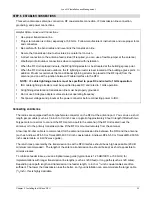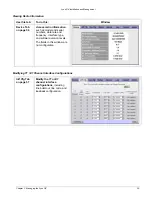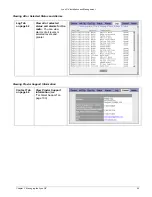
Lynx.GX Installation and Management
STEP 8. ESTABLISH A LINK BETWEEN THE RADIOS
Follow these steps to establish a link between the radios:
1) Connect the transmission line to the antenna and feed it to the RFU location.
Connect the opposite end of the transmission line to the N-type female connector located on the RFU through a
lightning arrestor. If the RFU is mounted indoors or in a shelter, the lightning protection should be located at the
cable egress point. If the RFU is mounted outdoors, it can be mounted at the RF input port of the RFU. The
lightning arrestor must be properly grounded. The transmission line connection must be terminated into an
antenna or a load before DC power is applied to the radio.
2) Connect the RFU to the IDU.
Connect the cable the runs from the RFU to the IDU. If the RFU is mounted outdoors, ensure that proper
lightning protection is used at the shelter or building egress point as well as at the RFU connector. The lightning
arrestor must be properly grounded. If the RFU is mounted indoors, use the supplied TNC jumper cable. No
grounding or lightning arrestor is needed.
3) Confirm DC power connection.
With the DC power source active but not plugged into the radio, confirm with a voltmeter that the DC mating
connector has the proper power connections as discussed in “Power Connections” on page 27.
▪
Verify the polarity and the absolute voltage on all pins.
▪
Verify ground connection for power (if applicable).
▪
Ensure that the RF Antenna port connection is properly terminated before applying power.
▪
Ensure that the IDU-to-RFU cable is connected.
4) Connect power to the radio.
When the radio is initially powered-on, some alarm conditions may be present. This is normal and alarms can be
ignored at this time.
5) Ensure that the antennas at both ends are aligned.
Perform a general alignment of the antennas on both ends of the path using binoculars, compass, or other
related tools. You must have the antennas aligned as accurately as possible before putting radio traffic over the
link. This helps in getting the system running more rapidly. Assure that both antennas are set for the same
polarization (vertical or horizontal at both ends).
6) Adjust RF power (if necessary).
Using the NMS port, verify the RF output power setting and, if necessary, adjust the output power of the local
transmitter in accordance with the path analysis calculations.
In cases of no EIRP limits, the radio transmitter output power should be left at the factory setting, except for very
short paths using very high gain antennas, where excessive power may not be advised (in which case power
should be reduced), or in cases where lower RSL is desired into a hub site (multi-link) location.
Be sure the RF output port is terminated at all times when power is applied to the radio. Therefore, disconnect
power to the unit before connecting a power meter; reapply power once connected.
Chapter 2. Installing the IDU and RFU
28






























